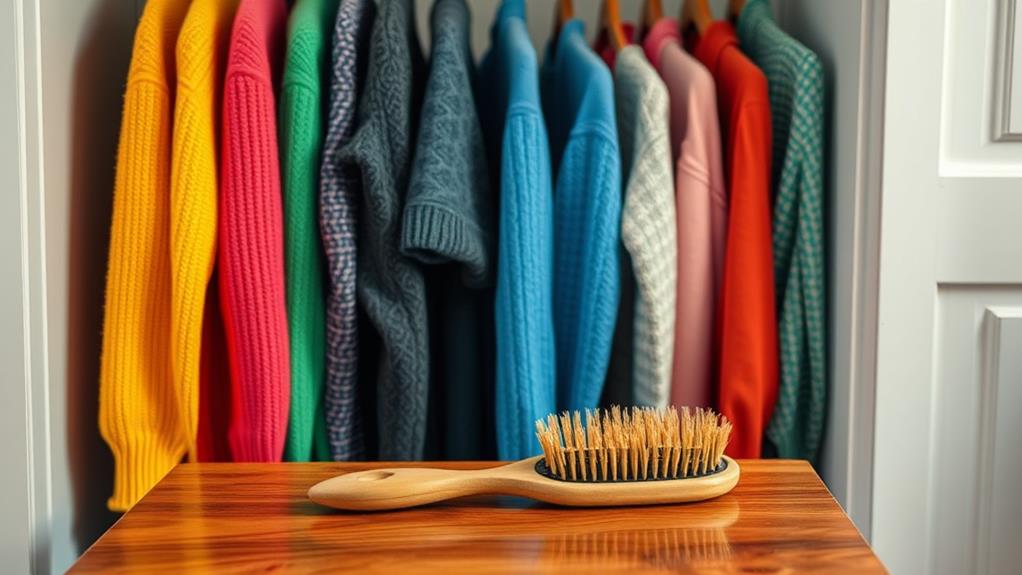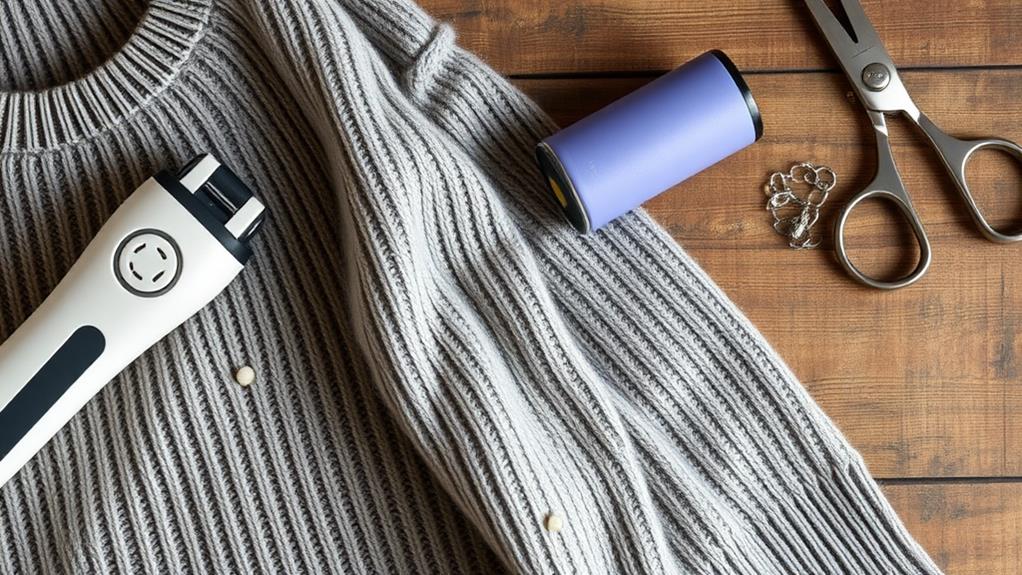You can easily keep your wardrobe looking fresh by using a few affordable methods to remove pilling from your clothes. Grab a cheap razor and gently shave the pilled areas, or use a lint roller to pick up any leftover fibers. For stubborn pills, tweezers or sticky tape work well. Prevent future pilling by washing clothes inside out on a gentle cycle and air-drying them. Regular inspections help catch pilling early. With these tips, your garments will maintain their appearance for longer. There's plenty more to discover about keeping your clothes in top shape!
Essential Supplies for Pilling Removal
When you're ready to tackle pilling on your clothes, having the right supplies makes all the difference. To effectively remove those pesky pills, start with a cheap, no-frills razor. This tool is perfect because it doesn't have moisture strips that can actually worsen pilling.
You'll want to keep your razor clean during the process, so grab some paper towels for quick cleaning. Wiping off any debris guarantees your razor stays effective. Additionally, using tools that are cost-effective, like a budget-friendly solution, can greatly enhance your overall approach to maintaining your wardrobe.
Next, don't forget a lint roller. It's an excellent tool for picking up the leftover pilling after you've shaved the fabric. This will help maintain a clean and fresh appearance for your clothing.
When using your razor, focus on areas with visible pilling, as this method is designed specifically for those fabric imperfections.
Avoid using expensive razors with added features, as they can lead to more pilling rather than removing it. Stick to the essentials to achieve the best results.
With the right supplies in hand, you're all set to rejuvenate your wardrobe and keep your clothes looking their best!
Effective Methods to Remove Pilling
When it comes to removing pilling, you've got some effective options at your disposal.
Utilizing AI-driven tools can enhance your product discovery for fabric care items, ensuring you find the right solutions.
The razor shaving technique is a simple yet powerful method, while electric fabric shavers offer a more automated solution.
Both can help restore your clothes to their original look, so let's explore how to use them effectively.
Razor Shaving Technique
A sharp razor can be your best friend in the battle against pilling on clothes. The razor shaving technique is an effective way to remove pills and keep your garments looking fresh. Here's how to do it right:
- Choose the right razor: Use a clean, no-frills razor with a sharp blade. Avoid moisture strips that could snag delicate fabrics.
- Pull the fabric taut: Gently stretch the fabric while shaving to maintain control and prevent cutting through your clothes.
- Wipe frequently: Keep your razor effective by wiping it with a paper towel often to remove lint and pills.
- Work on a hard surface: Shave on a flat, hard surface instead of a soft one, like carpet, to achieve better results.
Regularly inspecting your garments for pilling and addressing it promptly with this razor technique is key to proper care.
This affordable solution not only extends the lifespan of your clothes but also enhances their appearance, ensuring you look your best without breaking the bank.
Electric Fabric Shavers
Electric fabric shavers are a fantastic tool for quickly tackling pilling on your clothes. These devices are designed specifically for removing pilling efficiently, often providing a faster solution than manual methods. When used correctly, an electric fabric shaver can restore heavily pilled garments to their original state, making them look fresh and new again.
However, caution is necessary, especially with delicate fabrics, as improper use may cause damage. It's crucial to start by testing the shaver on a small, inconspicuous area to verify compatibility with your fabric.
Most electric fabric shavers feature a rotating blade that trims off pills without harming the underlying material, making them a popular choice for regular garment maintenance.
While they're an effective way to remove pilling, some users find electric fabric shavers less reliable than manual methods, such as using a razor or pumice stone. Results can vary across different fabric types, so be prepared for some trial and error.
To maximize effectiveness, consider using an electric shaver as part of your overall strategy to prevent pilling and keep your clothes looking their best.
Strategies to Prevent Pilling

Preventing pilling is essential for keeping your clothes looking fresh and new. By taking a few proactive steps, you can greatly reduce the risk of pilling and extend the life of your favorite garments. Here are some effective strategies to prevent pilling:
- Choose the Right Fabric: Opt for tightly woven fabrics like twill or denim. They're less prone to pilling than loosely constructed materials such as cotton or wool. Supporting eco-friendly stores that prioritize sustainable fabrics can also help you select higher-quality materials that resist pilling.
- Wash Inside Out: Always wash your clothes inside out using cold water and gentle detergents. This protects the outer fibers from abrasion, lowering the chances of pilling.
- Use a Gentle Cycle: Avoid overloading the washer. Use a gentle cycle to minimize friction between fabrics during washing, which can lead to pilling.
- Air Dry: Whenever possible, opt for air drying instead of tumble drying. High heat can fray fibers and increase the likelihood of pilling, damaging your clothes.
Regularly inspect your fabrics for early signs of pilling and address them promptly to maintain their appearance.
Understanding Lint Vs. Pilling
Pilling and lint are two common issues that can plague your clothes, but they're quite different in nature. Pilling occurs when small balls of tangled fibers form on the surface of fabrics, usually due to friction in high-contact areas like underarms or between thighs. This often happens with natural fibers such as wool and cotton, while synthetic fibers like polyester tend to resist pilling.
Notably, just as you can manage clothing issues like pilling, you can also streamline your financial organization with expense management apps that offer advanced features for tracking expenses.
On the other hand, lint is simply loose fibers, dust, and debris that accumulate on fabric surfaces. You can easily remove lint with tools like lint rollers or sticky tape.
Understanding lint vs. pilling is vital for effective clothing maintenance. While you can quickly remove lint with simple cleaning methods, stubborn pills require more targeted approaches.
For delicate items, it's important to be gentle when trying to remove pilling; using a fabric shaver or a fine razor can help without damaging the fabric.
By recognizing the differences between these two issues, you can choose the right removal technique, ensuring your clothes remain looking fresh and new.
Whether dealing with stubborn pills or simply needing to remove lint, knowing the distinction will make your laundry routine much more efficient.
Community Tips and Experiences

Over time, many community members have shared their tried-and-true methods for tackling pilling on clothes, creating a wealth of practical advice.
Here are some top tips to take into account:
1. Use a cheap razor: Many have found success with inexpensive razors for effective pilling removal. Just remember to keep it clean by wiping it with a paper towel during use.
Utilizing tools like these can be likened to how freelancers manage their finances with expense tracking apps to keep things organized.
2. Turn garments inside out: Before washing, turning your clothes inside out protects the fabric fibers and minimizes pilling, which has garnered positive feedback from various users.
3. Utilize lint rollers or sticky tape: These tools are perfect for quickly lifting pills and lint from your clothing, providing an easy, affordable maintenance solution.
4. Practice regular garment inspections: By routinely checking your clothes for pilling, you can guarantee prompt pilling removal, extending the life and appearance of your favorite items.
Handling Stubborn Pilling
Handling Stubborn Pilling
When you're dealing with stubborn pilling, it's important to have the right tools and techniques at your disposal. Start by evaluating the severity of the pilling from clothing. For those pesky pills that just won't budge, using tweezers can be effective. They allow you to grip and pull away the most stubborn pills that resist other methods.
For hard-to-reach areas, like seams, scissors work wonders. Snip away any pills before moving on to using a fabric shaver for overall smoothness. Choosing eco-friendly brands may also provide you with higher-quality fabrics that are less prone to pilling.
If the fabric is particularly stubborn, consider gently dampening the fabric. This can help loosen the pills, making them easier to remove. You can also use a fine-grit sandpaper block to help with this process.
If you prefer a quicker option, electric fabric shavers can efficiently tackle heavily pilled garments. Just remember to avoid pressing too hard, as this could damage the fabric.
After you've successfully removed stubborn pilling, it's a good idea to clean the garment with a damp cloth. This will help eliminate any leftover lint and prevent future buildup, keeping your wardrobe looking fresh and neat.
Regular Maintenance Techniques

To keep your clothes looking their best, you should regularly inspect them for pilling and tackle any issues as soon as you spot them.
Implementing clear maintenance techniques can help reduce the occurrence of pilling. Washing garments inside out and using gentle cycles can greatly reduce the risk of pilling during laundry.
Don't forget to use a lint roller or fabric shaver as part of your routine to maintain a fresh appearance.
Routine Inspection Practices
Regularly inspecting your garments is essential for keeping them looking their best and preventing pilling. By incorporating routine inspections into your maintenance schedule, you can catch issues early and extend the life of your clothes.
Here are some practices to help you effectively check for pilling:
- Inspect Monthly: Look for visible pills, especially in high-contact areas like underarms, sleeves, and waistband seams.
- Pre- and Post-Wash Checks: Always check for pilling before and after washing to assess your laundering techniques and make adjustments as needed.
- Quick Removal: Use a lint roller or sticky tape during your inspections to quickly remove any visible pills and lint, keeping your garments fresh.
- Proper Storage: Store clothes properly by folding or hanging them to minimize friction and abrasion that can lead to pilling. Always inspect your garments before putting them away.
Timely Pilling Removal Techniques
Addressing pilling promptly is key to maintaining the appearance of your clothes. To keep your wardrobe looking fresh, you should regularly inspect your garments for any signs of pilling. When you spot those pesky pills, act quickly to remove them. One effective method is using a fabric shaver; it's efficient and can make a noticeable difference in your clothing's look.
If you don't have one, you can also use a cheap, sharp razor—just be gentle and wipe the blade with a paper towel frequently for best results.
To prevent future pilling, turn your clothes inside out before washing. This minimizes friction on the outer fibers, which can contribute to pilling. Additionally, wash delicate items using detergents designed for delicate fabrics on gentle cycles, and avoid overloading the washer to reduce agitation.
Implementing routine maintenance, like using lint rollers, can help keep your clothes pill-free between washes.
These tips on removing pilling won't only preserve your clothes' appearance but also extend their lifespan, ensuring your wardrobe stays looking fresh and fashionable.
Recommended Products for Pilling Care
When it comes to removing pilling from clothes, having the right products at your disposal can make all the difference.
Regular monitoring of your clothing's condition is essential for maintaining its longevity, much like tracking your savings and investments for financial health.
Here are some recommended products that can help you keep your wardrobe looking fresh:
- Fabric Shavers: These electric devices are designed to tackle pilling effectively, though user reviews vary on their overall value.
- Pumice Stone: One of the safest and most affordable options, a pumice stone can easily remove pills from various fabrics and is readily available at pharmacies.
- Lint Rollers: Perfect for quick fixes, lint rollers can lift minor pills and lint from your clothes, making them handy for everyday maintenance.
- Tweezers: For those stubborn pills that seem resistant to other methods, tweezers allow you to gently pull away pilled fibers without damaging the fabric.
Additionally, consider using dryer sheets to reduce static and help prevent future pilling.
With these tips on removing pilling, you can keep your clothes looking their best, ensuring your wardrobe stays fresh and appealing.
Conclusion
By tackling pilling head-on, you can breathe new life into your favorite clothes, just like a gardener revives a wilting plant. Remember, a little regular care goes a long way. Whether you're using a lint shaver or a simple comb, you'll keep your wardrobe looking fresh and vibrant. So, don't let those pesky pills take over—embrace these affordable solutions and watch your clothing bloom again, ready to shine in your everyday style!



